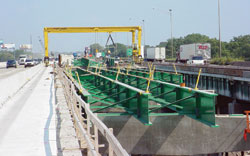| |
 |
At 50 years, the Interstate systemand the U.S. highway building industry in generalfaces a mid-life crisis. The nations population and number of vehicle miles traveled are increasing, yet the purchasing power of the highway trust funds fuel tax revenue is decreasing. This is one 50-year-old entity with clogged arteries and a dwindling pension plan.
But private investors are ready to help whip the highway system into shape. As the next half-century of road work moves forward, road-use fees and private-sector investors will play ever-stronger roles. Tolling, rejected for the Interstates creation, may be responsible for much of its rebirth. Development concessions and private-public partnerships (PPP) will spur more design-build and partnering.
These emerging trends are born of necessity. We are truly in a mobility crisis, says Geoff Yarema, partner with Los Angeles-based Nossaman Guthner Knox Elliott LLP. We cannot do anything that will have much of an impact in the next decade. We will endure and hope we can prepare for the decade or two after that.
The current $283-billion SAFETEA-LU Act falls short of whats needed just to maintain existing networks. As the U.S. population swells, decreasing congestion is almost too ambitious a goal, says Mike Carragher, transportation senior vice president for Vanasse Hangen Brustlin Inc., Watertown, Mass. Were trying to build a 21st-Century transportation system but were currently doing it with an Eisenhower-era funding mechanism.
So state agencies are turning to innovative funding methods, which often just involve different ways of borrowing rather than a truly different source of revenue, says Charlie Howard, transportation and planning director for the Puget Sound Regional Council, a metropolitan planning agency based in Seattle.
 |
| Tolling. Illinois has an ambitious toll construction program, with design-build contracts. |
The agency is studying new ways to charge user fees, such as using Global Positioning System technology. In a study due to end in March, it outfitted 500 volunteers cars with GPS devices. Each has a virtual bank account from which money is deducted based on driving patterns. The hope is that variable tolls, based on time of day and route, may alter driving habits and raise money for construction. This and other ideas, such as Illinois open tolling program, may help manage demand and raise revenue.
Not that the trust fund is going away any time soon. The gas tax is the bedrock for the federal highway program and quite a few state programs, says Jack Basso, director of business development for the American Association of State Highway & Transportation Officials. That will continue at least through 2015. Its a fundamental tool. But Basso and others agree that the fuel tax just isnt enough. With inflation, the purchasing power of the current 18.3¢ gas tax will be worth only 13.5¢ in 2009.
 |
| Warne |
The highway trust fund is at a crossroads of historic proportions, says Tom Warne, a South Jordan, Utah-based transportation consultant. We cant keep spending the trust-fund money at current levels without it going into negative balance. Raising taxes in 2008 will be tough, and Warne predicts the next highway bill will only keep the status quo. States will not be able to build future programs based on a big funding bump in 2009, he warns.
This looming shortage has motivated federal and state leaders to embrace alternative funding methods. New state PPP legislation has allowed Georgia Transportation Partnersa team of San Francisco-based Bechtel Corp., Peachtree, Ga.-based Gilbert Southern Corp., and Marietta, Ga.-based C.W. Matthews Contracting Co.to propose 26 miles of Atlanta-area Interstate expansion in new toll roads, truck-only toll lanes and/or congestion-priced tolling.
Dave Bauer, senior vice president of government relations for the American Road and Transportation Builders Association, says a reauthorization task force is working to develop a consensus on financing methods and policy reforms. SAFETEA-LU expanded innovative finance and nontraditional ways of funding, but not far enough, he says. For example, a just-published set of guidelines in the Federal Register allows private-sector tax-exempt bonds to be used for transportation projects, but caps the total at $15 billion. Going forward, we need to make private activity bonds permanent and without a cap, says Yarema.
Under SAFETEA-LU, Nevada received a five-year, $1.3-billion allocation, says Jeff Fontaine, Nevada Dept. of Transportation director. Thats a 30.1% funding increase over the previous bill, but it will still fall $4 billion short of the states needs over the next 10 years. Gov. Kenny Guinn (R) created a task force to study funding options and will report to the state Transportation Board in July. The blue ribbon task force is exploring public-private partnerships and managed lanes, says Fontaine. The biggest learning curve is the whole financial package.
To address that learning curve, some states plan PPP seminars. State DOTs are trying to get a groundswell of support to effect legislation for PPPs and design-build, says David Palmer, infrastructure principal in Arups New York City office. Weve seen more activity in the past year than wed seen in the past decade.
|
Looking In
Foreign development concessionaires view the U.S. highway market as a ripe investment opportunity. Weve been looking globally at infrastructure since the 1990s, says Christopher Leslie, managing director of Australias Macquarie Securities (USA) Inc. We looked at the U.S. as a very large market but [not] accustomed to our funding techniques. Its taken the last five years to educate the market.
Leslie says its too early to predict how much private sector road investment will catch on in the U.S., but notes that states like Texas and Virginia have made great strides in PPP. Virginia is reviewing private-sector proposals for a $1-billion, 50-year contract to operate the Dulles Toll Road. And two consortiums have proposed adding lanes to I-81, with tolls to pay for the work. A lot of states are looking at the I-81...

Post a comment to this article
Report Abusive Comment